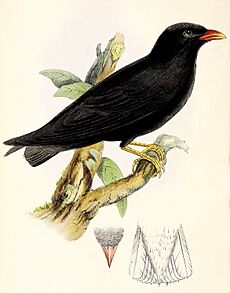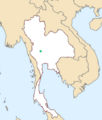White-eyed river martin facts for kids
Quick facts for kids White-eyed river martin |
|
|---|---|
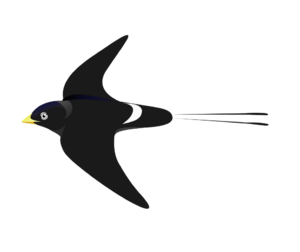 |
|
| Conservation status | |
| Scientific classification | |
| Genus: |
Pseudochelidon
|
| Species: |
sirintarae
|
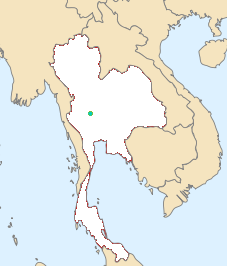 |
|
| Spot shows former wintering location within Thailand; the breeding range is unknown. | |
| Synonyms | |
|
|
The white-eyed river martin (Pseudochelidon sirintarae) is a special type of bird in the swallow family. It's one of only two birds in its unique group, called river martins. It's quite different from its closest relative, the African river martin. Because of these differences, some scientists think it should be in its own special group called Eurochelidon.
This bird was first discovered in 1968. It is only known from one place in Thailand where it spent the winter. Sadly, it might be extinct because no one has seen it since 1980. People have searched for it in Thailand and nearby Cambodia, but without luck. It's possible it still lives and breeds in China or Southeast Asia.
Adult white-eyed river martins are medium-sized swallows. They have shiny greenish-black feathers and a white patch on their back near the tail. Their tail has two long, thin feathers that widen at the end, like little rackets. They have a white ring around their eyes and a wide, bright greenish-yellow beak. Males and females look similar. Young birds don't have the long tail feathers and are browner.
We don't know much about how this martin behaves or where it breeds. Like other swallows, it catches insects while flying. Its wide beak suggests it might eat larger insects. In winter, it rests in reed beds at night. It might build nests in river sandbanks, probably in April or May before the rainy season. This bird might have been hard to find because it preferred to feed at dawn or dusk, not during the day.
The white-eyed river martin's disappearance might be due to trapping, loss of its home, and new dams. The number of swallows at the only known wintering spot for this martin has dropped a lot. Birds that live near rivers have also declined in the area. The white-eyed river martin is one of only two birds found only in Thailand. The Thai government has honored it with a special stamp and a valuable coin.
Contents
Meet the White-Eyed River Martin
The white-eyed river martin is part of the swallow family. It's one of just two birds in the river martin group, called Pseudochelidoninae. The other is the African river martin from Africa. These two birds have special features that make them different from other swallows. They have strong legs and feet, and thick beaks.
Their differences and the huge distance between where they live suggest they are old types of birds. They probably separated from other swallows very early in their evolution. Scientists have found genetic proof that this group is unique. Also, their habit of nesting in burrows is thought to be how the first swallows lived.
Discovery and Naming
The white-eyed river martin was found in 1968 by Thai bird expert Kitti Thonglongya. He gave the bird its scientific name, Pseudochelidon sirintarae. The name Pseudochelidon means "false swallow" in Ancient Greek. The species name sirintarae honors Princess Maha Chakri Sirindhorn of Thailand.
The African and Asian river martins have very different beak and eye sizes. This suggests they eat different kinds of food. The white-eyed river martin likely eats much larger prey. The Thai bird also has a hard, swollen mouth opening, unlike the softer one of the African martin. Some experts even suggested putting the white-eyed river martin in its own group, Eurochelidon, because it's so different.
What Does It Look Like?
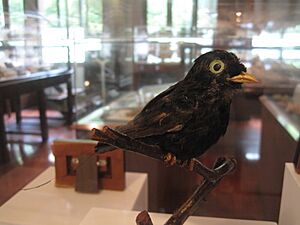
The adult white-eyed river martin is a medium-sized swallow, about 18 cm (7 in) long. It has mostly silky black feathers with a white patch on its lower back. Its back is glossy green-black, separated from its tail by a bright white band. Its head is darker than its back. The underside of its body is glossy blue-green black.
Its wings are black. The tail is green-glossed black and has two long, thin central feathers. These feathers can be up to 9 cm (3.5 in) long. They widen slightly at the tips, forming narrow "rackets" that are about 4.9 to 8.5 cm (1.9 to 3.3 in) long. The average wing length is 11.5 cm (4.5 in), and the tail is 10.7 cm (4.2 in) long.
The bird's eye and eyelid are white, making it look like it has a white eye ring. Its wide, bright greenish-yellow beak has a black hooked tip. Its large, strong feet and legs are flesh-colored. This bird is quiet in winter. We don't know what sounds it makes when breeding. Males and females look alike. Young birds do not have the long tail feathers. They have a brown head and chin and are generally browner than adults.
Local people in Bueng Boraphet in Thailand called this bird nok ta phong, which means "bird with enlarged eyes." After its official discovery, it was named nok chaofa ying sirinthon, meaning "Princess Sirindhorn bird."
Where Does It Live?
The white-eyed river martin was found in 1968 by Kitti Thonglongya. He got nine birds from hunters at a night-time resting spot. This spot was at Thailand's largest freshwater lake, Bueng Boraphet, in Nakhon Sawan Province. Bird experts first saw the bird in the wild at this same wintering site in 1977.
The species has only been seen at this lake, always between November and February. It is believed that its winter home is near open fresh water for feeding. It also needs reed beds for sleeping at night.
The white-eyed river martin might be a migratory bird. If its breeding home is like that of the African river martin, it would be in the forested valleys of large rivers. These places can offer sandbars and islands for nesting. They also provide woodlands where the birds can catch insects. We don't know where it breeds, but river valleys in northern Thailand or southwestern China are possible places.
A Chinese painting was once thought to show this bird, suggesting it might breed in China. The bird in the painting had a similar head, beak, white eye, and long tail. However, it lacked the white rump and the correct beak color. Also, the painting showed the outer tail feathers as long, not the central ones. This painting was made before 1970, so it must have been painted from a real bird. Now, experts think the painting more likely shows oriental pratincoles. Cambodia and Myanmar have also been suggested as possible places where the martin might live.
Behavior and Life Cycle
Since its breeding grounds are still a mystery, we don't know anything about the white-eyed river martin's breeding habits. It's thought that it might nest in burrows in river sandbars. This would likely happen in April or May, before the monsoon rains raise water levels. However, its feet and toes are quite different from its African relative. This has made some experts wonder if it even nests in burrows at all. In winter, it rests at night with barn swallows in reed beds.
Like other swallows, the white-eyed river martin eats insects, including beetles. It catches them while flying. Because of its size and unique mouth, it might eat larger insects than other swallows. This bird is described as graceful and light in flight. Like its African relative, it seems to avoid perching on branches. This behavior, along with its unusual toe shape and the fact that mud was found on the toes of one bird, suggests it might spend a lot of time on the ground.
Some experts believe that because of its unusually large eyes, this species might be active at night or at dawn and dusk. This could explain why it stayed hidden for so long. Even though the first birds were supposedly caught resting at night, it's possible they weren't caught at their roost. Or, they might be active both day and night, or just at dawn and dusk, depending on the season.
Why Is It So Rare?
The white-eyed river martin was seen in Thailand in 1972, 1977, and 1980. But there hasn't been a confirmed sighting since then, though one was reported in 1986. The only color photos of a living bird are of one caught and tagged in 1968. This bird is now listed as Critically Endangered. This is the highest risk category given by the International Union for the Conservation of Nature and Natural Resources (IUCN).
Being "Critically Endangered" means a species' numbers have dropped, or will drop, by 80% within three generations. The IUCN doesn't declare a species extinct until many detailed searches have been done. But the white-eyed river martin might already be gone from the wild. It was probably always a rare bird.
The number of swallows at Bueng Boraphet has dropped sharply. In 1970, hundreds of thousands of swallows were reported there. But in the winter of 1980–1981, only 8,000 were counted. It's not clear if this is a real decline or if the birds moved due to hunting. Other reasons for the martin's decline include disturbance of river sandbars and the building of dams. Dams flood areas upstream and change water flow downstream. Deforestation and turning its habitat into farmland also hurt the birds. Other birds in Southeast Asia that use river sandbars have also been affected by disturbance and habitat loss.
Very few swallows now rest in the Bueng Boraphet reedbeds. They prefer sugarcane fields instead. Despite searching, the white-eyed river martin has not been found in other large swallow roosts nearby.
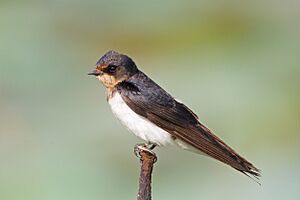
The martin is legally protected under Appendix 1 of the Convention on International Trade in Endangered Species of Wild Fauna and Flora (CITES) agreement. This is the highest protection level. It's also one of 15 "Reserved Species" in Thailand. This means it cannot be hunted, collected, or kept in captivity.
Even with official protection, local people caught the martin and other swallows. They sold them for food or for release by religious Buddhists. After bird experts discovered it, trappers reportedly caught as many as 120 martins. They sold them to a fisheries station director, but the birds couldn't survive in captivity. Two birds sent to Bangkok Zoo in 1971 also died quickly. This small population may not have been able to survive.
Bueng Boraphet has been made a Non-Hunting Area to protect the species. But searches for this martin have not been successful. These searches include several at the main site, a 1969 survey of rivers in northern Thailand, and a 1996 survey of rivers in northern Laos. A possible sighting was made in Cambodia in 2004. But a 2008 search there found no clear proof and noted the habitat was in poor condition. Still, some large animals, like the saola, have been rediscovered in Southeast Asia. So, it's possible a small group of martins still exists.
The white-eyed river martin and the Deignan's babbler are the only bird species found only in Thailand. The martin has gained enough interest to be featured on a 75 satang postage stamp in 1975. It was part of a set of four Thai birds. It also appeared on a 5,000 Thai baht gold coin in 1974, made for conservation.
Images for kids



